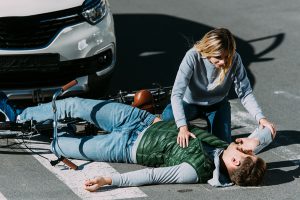8 Things To Do If You’ve Been In A Bicycle Accident
 Michael Babboni
Personal Injury
The weather in St. Petersburg is always perfect for biking. Not only is it great exercise, it also helps the environment by reducing emissions that come from motor vehicle usage.
Michael Babboni
Personal Injury
The weather in St. Petersburg is always perfect for biking. Not only is it great exercise, it also helps the environment by reducing emissions that come from motor vehicle usage.Unfortunately, the National Highway Traffic Safety Administration reports that over 50,000 bicyclists are injured in accidents with motor vehicles each year. If you are ever involved in a bicycle accident with a motor vehicle, here are 8 things to do that can have an impact on your treatment, recovery, and future compensation.
• Remain calm. It might be easier said than done, but staying calm is the best way to ensure that you make the right decisions as events unfold. Call 911 to alert the police to the accident scene. Do not approach the other party to apologize, and don’t tell anyone that you are “okay” if they ask how you feel.
• Wait for the police. Even if you think that you are not injured, it is vital to wait for the police to arrive. Minor injuries at the scene can develop over time. You need the police to document everything in a report so you can identify the at-fault driver in the future should those injuries become severe.
• Assess your injuries. While you wait, give yourself a look over to determine if your injuries need immediate attention. If so, let the ambulance crew know upon arrival that you need treatment. If your injuries are not severe, at least let the ambulance driver check you out and make a record. Tell them everything that is causing you even the slightest bit of pain.
• Give a statement to the police. Sometimes, police officers will speak only to the motorist and forget the bicyclist. Be sure that the police have your statement of the events in the police report. Include your injuries, no matter how minor you believe they are.
• Gather information. If possible, get the name, contact information, and insurance company information of the other driver. Write down the license plate number. Get contact information of anyone who witnessed the accident, including bystanders and passengers in the other car.
• Take pictures. If you can, take as many pictures of the entire accident scene as possible. From your bike, to the car, to the surrounding area, the more photo evidence you have, the better. If you have any visible injuries, such as cuts, scrapes, or bruises, take pictures of those as well.
• Document your injuries. Document your injuries and keep a record of how you feel. If you seek medical attention after the event, tell the doctor everything that hurts. Keep records of prescription medications, treatment plans, and procedures.
• Seek advice from a professional. Accidents between bikes and cars involve complex issues. Consulting with an attorney can help you determine how to proceed, how to negotiate with the insurance company, or how to initiate a lawsuit. If filing a lawsuit, an attorney can investigate the accident to the very last detail to get you the best settlement possible.
